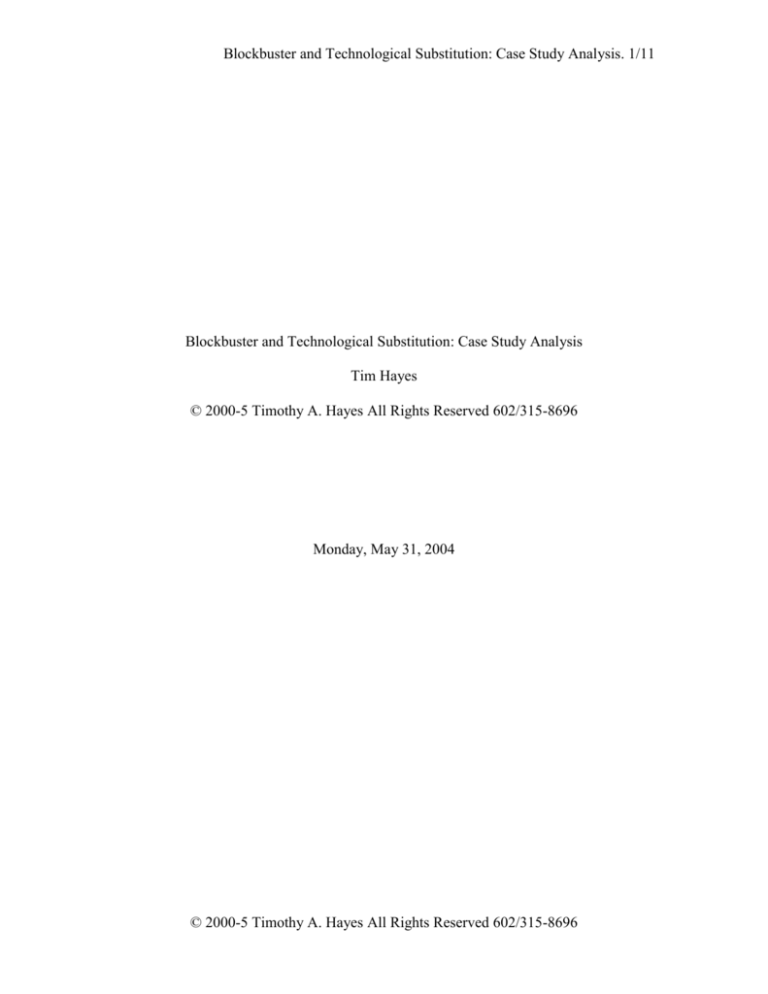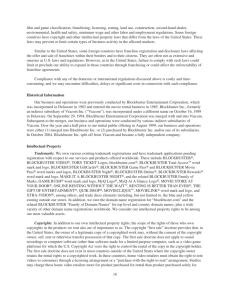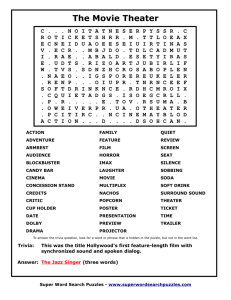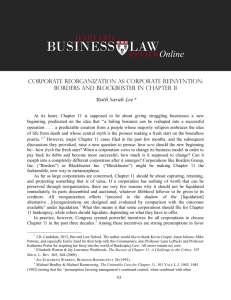
Blockbuster and Technological Substitution: Case Study Analysis. 1/11
Blockbuster and Technological Substitution: Case Study Analysis
Tim Hayes
© 2000-5 Timothy A. Hayes All Rights Reserved 602/315-8696
Monday, May 31, 2004
© 2000-5 Timothy A. Hayes All Rights Reserved 602/315-8696
Blockbuster and Technological Substitution: Case Study Analysis. 2/11
Introduction
Based on current market trends and forecasts, Personal Video Recorders (PVR)
and Video-on-Demand (VOD) both exhibit properties of disruptive technologies and a
possible threat to Blockbuster’s future market share. Pay-Per-View (PPV) will be
discussed in the analysis as a slightly lower threat since it is less disruptive and due to
Blockbuster’s partnership with DirecTV. Finally, home delivery of movies poses the
least threat to Blockbuster since it is a sustainable technology that should only threaten a
small market of existing customers that do not desire the convenience of a local video
store.
Key Stakeholders and Value Chain
There are several stakeholders in the movie industry. Studios and filmmakers
make up the first stakeholders. After a film is created, it is first released into the theater
market who is a second stakeholder. The film is then released into the video and DVD
market comprising a third stakeholder. Shortly after the movie is released for video
rentals, the film is released for PPV and VOD markets who makeup the fourth
stakeholder. Lastly, the film is released for television, the final industry stakeholder. In
addition, movie consumers are a stakeholder throughout the processes. Exhibit 1 shows
the stakeholders and revenue generation over time of a typical movie release process and
Exhibit 2 shows the value chain associated with the film industry.
© 2000-5 Timothy A. Hayes All Rights Reserved 602/315-8696
Blockbuster and Technological Substitution: Case Study Analysis. 3/11
Exhibit 1: Movie Industry Stakeholders Over time
Film Maker
Movie Consumers
Television
Pay-Per-View
Revenue
Rentals
Theaters
Relevant Time
Exhibit 2: Movie Industry Value Chain
MGM
Warner
Disney
CGI, film….
Delivery/Marketing
NetFlix
Blockbuster
Hollywood
Warner
DirecTV
Cinemanow
Movie Industry
Graphics
Enhancements
High Definition
Rental Market
Higher Res
Easier Playback
Ability to copy
Pay Per View
Internet
Satellite
Cable
Delivery Method
Specialized
Equipment
DVD Players
Digital Movies
Deliver Speed
Options
Key Issues
The key issue for Blockbuster is to identify the threats or combination of threats
for both long term and short term forecasts and create scenarios or real options to manage
the threats for future growth, profitability, and survival.
© 2000-5 Timothy A. Hayes All Rights Reserved 602/315-8696
Blockbuster and Technological Substitution: Case Study Analysis. 4/11
Analysis
The general threat to Blockbuster is that new technology will allow the movie
release process to be compressed and make Blockbuster, Hollywood video, and other
retail rental chains obsolete. Table 1 lists the current threats to Blockbusters continued
profitability and market share. Technological advances have made PVR and PPV viable
technology for present consumers. PPV alone only poses a medium threat to Blockbuster
since it cannot deliver the same features that DVD rentals provide, such as immediate
viewing, plenty of selection, and the ability to rewind and fast-forward. Additionally,
PVR alone poses only a medium threat to Blockbuster since it cannot distribute movies to
consumers. However, the combined technologies provide a much greater threat since
together they can mimic much of the services provided by Blockbuster. A consumer
could purchase a PPV movie and watch it using PVR technology to enable fast-forward,
rewind, pause and recording capabilities. Exhibit 3 shows the market penetration of PPV
as compared to the penetration of cable from 1987-2000.
Although the threat of PPV combined with PVR is high, it still cannot completely
replace the DVD rental market because it lacks timing and unlimited selection. Videoon-Demand (VOD) solves these problems, providing unlimited selection with timely
delivery. However, the technology necessary for wide spread VOD is not yet viable in
most areas. The VOD poses the highest threat to Blockbuster’s business model since
VOD includes all of the features of the renting a video and delivers it directly to
individual homes without the inconvenience of driving to a video store.
© 2000-5 Timothy A. Hayes All Rights Reserved 602/315-8696
Blockbuster and Technological Substitution: Case Study Analysis. 5/11
Table 1: Summary of Current Threats
Threat
Threat Level
Combined
Threat
Major Players
Technology
Type
Key Points
Personal Video
Recorders
(PVR)
Medium
Pay-Per-View
(PPV)
Medium
High
TIVO
SemiDisruptive
-Based on
recording
platform
-Creates VOD
like market
when combined
with PPV
-Allows
recording,
playback,
features for TV
and PPV
Video on
Demand
(VOD)
High
Home Delivery
Low
-
-
DirecTV
Cable Companies
Disruptive
COX, AOL,
Others
Disruptive
Netflix
-Allows viewing
of movies but less
options than
renting DVDs
-Possible prequel
to VOD
-Creates VOD
like market when
combined with
PPV
-Allows
completely
new channel
to replace
DVD Rentals
-Technology
still forming,
not yet viable
in many
markets
-Simply another
delivery
channel for
rental DVDs
-Sustaining in
nature, only a
variation of
Blockbuster’s
and Hollywood
Video’s
strategy
Sustaining
Exhibit 3: Comparison of Growth: PPV and Cable
120.00%
Percent of 2000 total
100.00%
80.00%
Cable
PPV
60.00%
40.00%
20.00%
0.00%
1987 1988 1989 1990 1991 1992 1993 1994 1995 1996 1997 1998 1999 2000
Year
© 2000-5 Timothy A. Hayes All Rights Reserved 602/315-8696
Blockbuster and Technological Substitution: Case Study Analysis. 6/11
There are two types of VOD that threaten Blockbuster: Cable and Digital Cinema.
The difference between VOD and Digital Cinema is primarily in their method of
delivery. VOD is likely to compete with Blockbuster’s market share as soon as
technology is suitable for delivery over cable or satellite. Furthermore, VOD through is
able to target both new and existing customers since a large part of the TV owners
already have cable or satellite connections and use their TVs as viewing stations. The
second delivery method, Digital Cinema, also requires some technology improvements
before it can compete with Blockbuster. The market penetration of Digital Cinema will
likely be further in the future than VOD through cable since it will require either a
migration of viewers from watching movies on TV to watching movies on computers or
an integration of computers and TV technology enabling viewers seamless connections
between computers and televisions. Exhibit 4 illustrates the potential threat to
Blockbuster of each disruptive technology over time.
Market Penetration
Exhibit 4: Potential Threat Over Time
Digital Cinema
VOD
PVR
2010
Year
2005
2000
1995
Pay-Per-View
© 2000-5 Timothy A. Hayes All Rights Reserved 602/315-8696
Blockbuster and Technological Substitution: Case Study Analysis. 7/11
Decision Alternatives and Scenarios
Exhibit 5 summarizes four scenarios derived from the analysis above. Each
scenario poses a different type of threat to Blockbuster’s business model and ranges in
intensity and duration.
Exhibit 5: Scenario Framework 1
Minor Change
Traditional
Scenario 1
New
Scenario 2
Radical Change
Netflix
Scenario 3
Personal Video Recorder
Scenario 4
Pay-Per-View
Video-On-Demand
Digital Cinema
Scenario 1
Scenario 1 provides little threat to Blockbuster. It is unlikely that Netflix will be
able to offer a service that establishes a new or emerging market or takes significantly
away from Blockbusters existing market. The inconveniences of mailing DVDs and not
receiving movies instantly will reduce the overall market impact of Netflix. It is unlikely
that the sustaining technology or business concept will progress greatly from its current
state.
Scenario 2
Scenario two poses a greater threat to Blockbuster than Scenario 1. Assuming the
market share of TIVO and other PVR companies increase dramatically, customers would
be able to record movies from cable or television. This would cut into Blockbusters
revenue from older releases, but poses little threat to new releases not yet released for
cable or television. The ability to record movies alone does not add the same type of
© 2000-5 Timothy A. Hayes All Rights Reserved 602/315-8696
Blockbuster and Technological Substitution: Case Study Analysis. 8/11
functionality that Blockbuster offers; therefore, the scenario of PVR alone does not pose
a significant threat to Blockbuster.
Scenario 3
Pay-Per-View poses a more serious threat to Blockbuster than PVR or Netflix.
Blockbuster currently keeps its edge over PPV by established release delays in addition
to the added features of rewind, fast forward, and pause. Assuming that studios start
allowing new releases to be viewed immediately using PPV, Blockbuster could lose
significant market share. Additionally, Blockbuster could lose further market share when
PVR and PPV technologies are combined. PVR market penetration currently stands at
around 7% and is expected to increase over the next 3 years to 20%. If studios begin
releasing movies directly to PPV and PVR customers use the service to record and playback PPV movies, Blockbuster stands to lose 20% of their new release market by 2007.
Thus, PPV combined with PVR poses a formidable threat to blockbuster.
Scenario 4
Scenario 4 demonstrates the greatest long term threat to Blockbuster’s business
model and existence. Video-on-Demand and Digital Cinema are both disruptive
technologies that contain the potential to completely eliminate the need for physical video
rental locations. However, the technology for wide-spread proliferation of VOD and
Digital Cinema is still several years away. Nevertheless, VOD and Digital Cinema is a
threat that Blockbuster should take the most seriously. Current trends show a significant
increase in cable VOD and computer technology is quickly moving towards integrating
computers with television, creating an integrated entertainment approach and increasing
the viability of Digital Cinema. The main uncertainty is whether Digital Cinema will be
© 2000-5 Timothy A. Hayes All Rights Reserved 602/315-8696
Blockbuster and Technological Substitution: Case Study Analysis. 9/11
made cheap enough for a significant number of consumers to afford. Exhibit 6 and 7
show the forecasted revenues for Video-On-Demand and Video Rentals. Notice how
VOD seems to take market share directly away from the video rental market whereas all
other means of distribution (exhibit 7) show complementary relationships of various
strengths and increasing revenues.
Exhibit 6: VOD vs. Rental Forcast
14000
12000
Revenue
10000
8000
Video Rental
Video On Demand
6000
4000
2000
0
2000
2001
2002
2003
2004
2005
2006
Year
© 2000-5 Timothy A. Hayes All Rights Reserved 602/315-8696
Blockbuster and Technological Substitution: Case Study Analysis. 10/11
Exhibit 7: Forcasted Revenu
16000
14000
12000
Video Rental
Revenue
10000
Video On Demand
8000
Television
Home Video Sales
6000
Theatrical Release
4000
2000
0
2000
2001
2002
2003
2004
2005
2006
Year
Recommendation
Blockbuster needs to seriously consider the long term threat of VOD and Digital
Cinema. Although PPV and PVR threaten to erode Blockbusters market share slowly
over time, VOD threatens to completely eliminate the need for video rentals.
Blockbuster adds value to the movie market by providing a distribution channel – linking
the studios with the customer. Although blockbuster can and has developed some
mutually beneficial partnerships with DirecTV and TIVO, those relationships will
diminish once customers are transferred away from Blockbuster. The partnerships itself
may eventually lead to decreased revenue for Blockbuster in the long run. Blockbuster
adds value to DirecTV by advertising DirecTV to its large customer base; however, the
relationship also erodes Blockbusters own customer base – the very reason DirecTV is
willing to partner with Blockbuster.
© 2000-5 Timothy A. Hayes All Rights Reserved 602/315-8696
Blockbuster and Technological Substitution: Case Study Analysis. 11/11
It is unlikely that Blockbuster will be able to change its business model to directly
compete with digital computer equipment makers or cable companies for VOD, PVR, or
PPV market. Therefore blockbuster needs to find ways to integrate itself into the new
markets by adding value to the movie release process once the video rental market is
diminished. One possible solution is for blockbuster to partner with VOD providers as a
local advertising, release, and support centers for satellite TV or cable corporations.
Blockbuster could complement the centrally based companies as satellite offices similar
to sprint PCS or AT&T stores.
© 2000-5 Timothy A. Hayes All Rights Reserved 602/315-8696







